

ODOROUS HOUSE ANTS swarmers emerging in homes;
DOGWOOD BORER and BRONZE BIRCH BORER flight;
WOOD COCKROACH entering homes;
ROSESLUG SAWFLIES on rose leaves;
STRIPED CUCUMBER BEETLES on cucurbits;
CORN ROOTWORM egg hatch;
increasing POTATO LEAFHOPPER populations;
FLY NUMBERS on cattle and horses


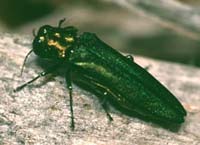 Hamilton County was added to the emerald ash borer (EAB) quarantine list for Ohio following the discovery of the insect in Anderson Township. The quarantine, designed to slow the spread of EAB, prohibits the movement of ash trees, parts of an ash tree, and all hardwood firewood out of Hamilton County. The news release with additional details is attached to this newsletter.
Hamilton County was added to the emerald ash borer (EAB) quarantine list for Ohio following the discovery of the insect in Anderson Township. The quarantine, designed to slow the spread of EAB, prohibits the movement of ash trees, parts of an ash tree, and all hardwood firewood out of Hamilton County. The news release with additional details is attached to this newsletter.
No EAB infestations have been found in Kentucky but at some point they will be. Adults begin to emerge from infested trees and will be active into late July. An EAB emergence hole is distinct, a flattened side gives it a D shape (see picture). The native ash borers we have in Kentucky (like the ash / lilac borer) chew round exit holes. The adult stage of this borer is a moth, a pupal case can be seen in the picture.
Suspected EAB infestations in Kentucky should be reported to your county extension office or directly to the Office of the State Entomologist at UK at (859) 257-7450.
Go to http://www.emeraldashborer.info/ for complete information on this insect. Follow the Links on the navigation bar to state maps of confirmed infestations.
REYNOLDSBURG, Ohio (May 23, 2007) - The Ohio Department of Agriculture today added Hamilton County to the list of Ohio's Emerald Ash Borer (EAB) quarantined counties, after discovering the ash tree-killing insect in Anderson Township. The quarantine, designed to slow the spread of EAB, prohibits the movement of ash trees, parts of an ash tree, and all hardwood firewood out of Hamilton County.
Department officials, after receiving a call from a concerned homeowner, discovered an infested ash tree off of Newtown Road in Anderson Township. The landscaped tree showed visible signs of EAB, including the insect's distinctive D-shaped exit holes in the bark. This marks the state's most southern point of infestation and illustrates the insect's inadvertent movement through infested ash tree materials.
All of Hamilton County is now quarantined, making it illegal to take hardwood firewood and ash tree materials into neighboring uninfested counties. These materials can move freely between Hamilton and Warren counties but cannot leave the two infested counties. Violators face fines up to $4,000. It is also illegal to take hardwood firewood and ash tree materials out of the state of Ohio, per federal quarantine.
Firewood dealers, businesses, or woodlot owners interested in marketing and transporting ash trees or firewood out of quarantined areas can do so only with a department-approved compliance agreement. These agreements stipulate handling practices that mitigate the spread of EAB.
Since it was first discovered in Ohio in 2003, EAB has been identified in 28 counties: Allen, Auglaize, Cuyahoga, Delaware, Defiance, Erie, Franklin, Fulton, Hamilton, Hancock, Hardin, Henry, Huron, Logan, Lorain, Lucas, Marion, Medina, Mercer, Miami, Sandusky, Seneca, Ottawa, Paulding, Warren, Williams, Wood, and Wyandot counties. All or parts of these counties have been quarantined to stop the movement of firewood and ash logs, which are the largest contributors to the spread of EAB. For the latest quarantine map, go to www.ohioagriculture.gov/eab.
Ash trees infested with EAB typically die within five years. The pest belongs to a group of metallic wood-boring beetles. Adults are dark green, one-half inch in length and one-eighth inch wide, and fly only from early May until September. Larvae spend the rest of the year beneath the bark of ash trees, and when they emerge as adults, leave D-shaped holes in the bark about one-eighth inch wide.
For more information on the latest quarantine or firewood movement, call 1-888-OHIO-EAB.
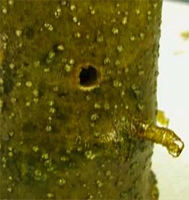
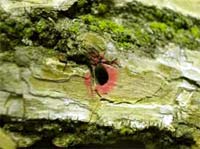
The Field School will be held June 21, 2007 at the UK Spindletop Research Farm on Ironworks Pike in
Fayette County. It is approved by the KDA for 4 general hours and 1 Category Specific hour or
Categories 1A, 10, 12, or14. Contact Dr. JD Green at 859-257-4898 for more information.


 Active blue mold is present in western Cuba (Pinar del Rio) as of May 29, 2007 and the disease has not been reported in the U.S at this time. The North American Plant Disease Forecast Center (www.ces.ncsu.edu/depts/pp/bluemold/) predicts a low level of risk to blue mold based upon this information. Hopefully we'll get through the transplant production season without blue mold - remember that it was this time last year that we started finding cases of blue mold in eastern KY linked to FL-produced plug plants. I am not ready to start waving the checkered flag, but have high hopes that we'll get our tobacco set without pressure from blue mold this year!
Active blue mold is present in western Cuba (Pinar del Rio) as of May 29, 2007 and the disease has not been reported in the U.S at this time. The North American Plant Disease Forecast Center (www.ces.ncsu.edu/depts/pp/bluemold/) predicts a low level of risk to blue mold based upon this information. Hopefully we'll get through the transplant production season without blue mold - remember that it was this time last year that we started finding cases of blue mold in eastern KY linked to FL-produced plug plants. I am not ready to start waving the checkered flag, but have high hopes that we'll get our tobacco set without pressure from blue mold this year!
We are beginning to see some severe cases of Pythium root rot as the weather warms. From this point in time onward, I would expect that this will be one of our biggest headaches and growers should keep a close watch on their plants that are still in float beds. Preventive measures (i.e. sanitary production practices and application of Terramaster at 1 fl oz per 100 gallons of float-bed water) should be taken to avoid losses or delays in transplant production. Warm conditions, along with injury or other stresses, will also favor bacterial soft rot, or blackleg. Refer to KPN No. 1124 (April 23, 2007) for tips on preventing and managing this disease.
For the latest blue mold status and other tobacco disease information, check the KY Blue Mold Warning System online.
![]() http://www.uky.edu/Agriculture/kpn/kyblue/kyblue.htm
http://www.uky.edu/Agriculture/kpn/kyblue/kyblue.htm

For more information about tobacco pests, visit "Insect Management Recommendations".

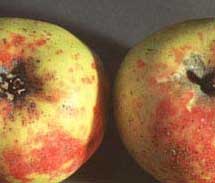 While most of our fruit trees don't have much of a crop to manage this year due to the late freeze in April, there are a few insect pests that can affect the health of the trees and should be managed. San Jose is one of those pests. While feeding these scale insects inject enzymes into the wood that are toxic and can cause limb dieback or even death of some peach and apple trees. Late May and early June is when the eggs of the first generation hatch and crawlers emerge. During most of the year, the scale nymphs and adults are protected from most insecticides underneath a waxy cap. During the motile crawler stage they are more vulnerable. This is one of the key periods for control of the scale. There is an emergence of crawlers later in the summer, but that generation is not synchronized, emerging over several weeks making control difficult.
While most of our fruit trees don't have much of a crop to manage this year due to the late freeze in April, there are a few insect pests that can affect the health of the trees and should be managed. San Jose is one of those pests. While feeding these scale insects inject enzymes into the wood that are toxic and can cause limb dieback or even death of some peach and apple trees. Late May and early June is when the eggs of the first generation hatch and crawlers emerge. During most of the year, the scale nymphs and adults are protected from most insecticides underneath a waxy cap. During the motile crawler stage they are more vulnerable. This is one of the key periods for control of the scale. There is an emergence of crawlers later in the summer, but that generation is not synchronized, emerging over several weeks making control difficult.

Several key pests of vegetables need to be controlled in the late spring, as control during this period will also help with their management later in the summer. Early in the season it is important to get the seedlings and vegetable transplants off to a good start. There are some of the early-season insects that need to be managed to ensure healthy stands.
Spring Cole crops (Cabbage, Broccoli)
Striped flea beetles, imported cabbageworm and diamondback moth larvae are the pests that attack the spring crop. With flea beetles on seedling plants, less than 4 to 5 true leaves, use a threshold of an average of two beetles per plant when deciding whether or not to spray. A threshold of 15 percent infested plants can be used with worms until either head-fill or crown formation, then the threshold drops to 5 percent infested plants. While the type of mixture of worms it is not important when deciding if to spray, the types of worms will determine which insecticides are used.
Sweet Corn
Corn flea beetles and cutworms are the two primary pests that will attack seedling corn. Use 3 percent cut plants with cutworms actively feeding as the guideline for treating cutworms. Flea beetles can transmit the bacterium that causes Stewart=s Wilt, so wilt resistant cultivars may be needed in years following mild winters. Otherwise the threshold for direct feeding by corn flea beetles is 50 percent of the plants with leaf scars and some leaves turning white.
Tomatoes and Peppers
Tobacco and potato flea beetles will attack both tomato and pepper plants. Usually, the plants will quickly outgrow moderate damage. Occasionally, serious damage can occur to plants less than six inches. Use 4or more beetles per plant and plants less than 6 inches as the guideline for treatment. Colorado potato beetle can also do serious damage to tomato plants less than 8 inches. Use 10 beetles per 20 plants as the guideline for treatment when the plants are less than 8 inches.
Eggplant and Potato
As with tomato, flea beetles and Colorado potato beetle are serious early season pests of potato and eggplant. Use the same threshold for tomatoes above. Resistant to insecticides continues to be a serious problem for Colorado potato beetle. Because of this, producers should not use insecticides with the same mode of action for consecutive generations of this insect. Often local populations of this insect may be resistant to one group of insecticides, and in other areas they may be resistant to others. For this reason, what works well in one county may not work at all in another. The new IRAC codes on the labels should help producers identify products that can be used in rotation.
Squashes, Cucumbers and Melons
Striped and spotted cucumber beetles can attack cucurbit crops anytime after seedling or transplanting. Cucumber beetles also transmit the bacterium that causes bacterial wilt. For this reason, cucurbit crops must be treated for cucumber beetles as soon as they are planted. With bacterial wilt susceptible crops, cucumber beetles need to be effectively controlled through the start of flowering. Keep in mind that cucurbits are insect pollinated, so measures need to be taken to control the beetles and avoid hurting pollinators. Method to avoid injuring pollinators during bloom are to spray in the early evening after pollinators have quit or to use a systemic just after transplanting. The flowers that are open will be closed the next day and new blooms free of insecticide on the inner surface will be open the following day. Squash bug will begin to arrive around June 1 and like cucumber beetles, it is also a disease vector (of Yellow Vine Decline), so it must be controlled early. As cucumber beetles and squash bug are disease vectors, we treat early in the season as soon as they are detected.


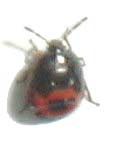 Burrower bugs are 1/8 to 1/4 inch long insects with sucking mouthparts. Adults are black with a thin gray
line around the edge of the body. The smaller nymphs, or immatures, are red and black . Both stages can
be seen crawling over and under the soil and surface residue or accumulating in cracks in the soil
surface. Burrower bugs can be abundant in and around no till soybean and corn fields, as well as
gardens and lawns. The species uses its sucking mouthparts to feed on sap from the roots of a wide
variety of plants.
Burrower bugs are 1/8 to 1/4 inch long insects with sucking mouthparts. Adults are black with a thin gray
line around the edge of the body. The smaller nymphs, or immatures, are red and black . Both stages can
be seen crawling over and under the soil and surface residue or accumulating in cracks in the soil
surface. Burrower bugs can be abundant in and around no till soybean and corn fields, as well as
gardens and lawns. The species uses its sucking mouthparts to feed on sap from the roots of a wide
variety of plants.
There is no indication that burrowing bugs cause any injury to crops but densities of several
dozen of these bright insects per square foot have raised the concern of farmers, dealers, and
commercial applicators. In some cases, migrating burrowing bugs have covered the sides of
buildings. They can be accidental invaders in lawns, and occasionally may enter houses. Sevin, Ortho Bug B Gone, or Bayer Advanced Garden Lawn and Garden Multi-Insect Killer may be used for control - see turf section of the labels.


 The foliage of many daylilies (Hemerocallis spp.) grown in Kentucky was injured by the cold temperatures of early April. Portions of leaves were bleached out and necrotic due to the freeze. Daylilies have largely recovered from the freeze damage, and thanks to dry spring weather, are mostly relatively disease-free. However, there is still a need to be wary of daylily leaf streak, a persistent and damaging disease of daylilies in Kentucky, and to a lesser extent, daylily rust disease. These diseases have been addressed over the years in this newsletter. For example, a more complete description of daylily leaf streak and its management was printed in Kentucky Pest News, #1019, dated May 3, 2004.
The foliage of many daylilies (Hemerocallis spp.) grown in Kentucky was injured by the cold temperatures of early April. Portions of leaves were bleached out and necrotic due to the freeze. Daylilies have largely recovered from the freeze damage, and thanks to dry spring weather, are mostly relatively disease-free. However, there is still a need to be wary of daylily leaf streak, a persistent and damaging disease of daylilies in Kentucky, and to a lesser extent, daylily rust disease. These diseases have been addressed over the years in this newsletter. For example, a more complete description of daylily leaf streak and its management was printed in Kentucky Pest News, #1019, dated May 3, 2004.
At that time, it was noted that daylily leaf streak susceptibility varied but that none were identified as being resistant. Recent experiments published in Plant Disease Management Reports, Volume 1 (available on-line to U.K. employees through the Plant Management Network) suggests that daylily cultivars vary in susceptibility to daylily leaf streak. Researchers G. E. Holcomb, A.D. Owings, and C.A. Broyles at Louisiana State University published an article entitled "Reaction of daylily cultivars to leaf streak infection, 2006." To simplify their results, cultivars could be grouped as follows.
In these same plots, the researchers also evaluated daylilies for reaction to daylily rust disease and published their results in the same on-line journal. For details of these tests, U.K. Extension Agents and Specialists are encouraged to visit the Plant Management Network https://www.plantmanagementnetwork.org/ and look under "resources" and Plant Disease Management Reports. In Kentucky, rust is less common, but could occur if the fungus is introduced by way of new plants.
The authors of the daylily disease evaluation results from Louisiana indicate that the following cultivars are least susceptible to both daylily leaf streak and daylily rust diseases: Bitsy, Black Eyed Stella, Frankly Scarlet, Lullaby Baby, Pandora's Box and Prairie Blue Eyes. Kentucky growers with these cultivars may want to compare them to other cultivars growing in the garden. In the research reported here, the cultivars Lady, Orange Crush, and Rose Pink could not be evaluated for leaf streak disease because of severe rust infection. Kentucky gardeners looking for an efficient way to maintain the health of daylilies in the garden would be wise to avoid highly susceptible daylily cultivars.
Diplodia tip blight research at U.K. has shown that the causal fungus not only produces symptomatic infections, but also latent, asymptomatic infections. It was found that there was no difference between the pathogenicity of the fungus in either type of infection. This would suggest that latency is created by the tree as opposed to the fungus. To see what differences occur microscopically in pine tissue between the two types of infections, portions of Austrian pines were preserved in resin, sectioned, stained, and then examined under light microscopy. Samples were taken from elongating shoots in May 2004, as well as lignified shoots in August 2004 and January 2005. Diseased shoots were only taken in May, but asymptomatic shoots were taken at all three collection times. Samples were cut in half, with one half preserved in Spurr's resin and the other half were, using PCR, tested to determine if D. pinea is present, even latently, in the tissue sample.
It was previously thought that D. pinea infects through the stomata, but it was found in these studies that D. pinea can penetrate directly into the host tissue, and most of this occurs at the needle bases. In the crevices between the needle base and the shoot, conglomerates of spores and fungal hyphae were found, no matter what time of year the samples were taken.
In diseased tissue (PCR positive), massive amounts of fungal hyphae were found, as compared to healthy (PCR negative) tissue where no hyphae were found within the pine tissue. This highly suggests that the fungus in the diseased tissue is in fact D. pinea. In these diseased samples, host tissue was severely degraded and this necrosis/tissue degradation always preceded fungal colonization, which suggests that the fungus is using toxins to kill pine tissue. In diseased samples, D. pinea was seen throughout the pine tissue, including the vascular tissues and pith. This extensive colonization was seen even in very mildly symptomatic shoots. This possibly explains why tips die so rapidly.
In latent infections (PCR positive), found in both expanding and lignified tissue, D. pinea was found in localized pockets of degraded cells in the cortex. Tissue degradation and fungal hyphae were not found in the xylem and tracheid tissues or pith. In a few samples, necrophylactic periderms (a lignified layer) were found separating the degraded colonized cortex from the cambium. These lignified layers were not found in all latent infections, but their precursor cannot be seen under the microscopic procedure used, so these layers could have been forming, but they just could not be seen. This suggests that if the pine reacts quickly enough to segregate the fungus and keep it from invading the vasculature, then symptomatic infections will not be formed.
This research helps explain the nature of latent infections in Austrian pine. Understanding latent infections in these trees is so important because they may make disease management more difficult.


Agronomic samples over the past week included phosphorus and zinc deficiencies on corn; and target spot, Pythium root rot, bacterial blackleg and transplant shock on tobacco.
On fruit and vegetable samples we have diagnosed frogeye leaf spot on apple; Sclerotinia ("lettuce drop") on lettuce; and transplant shock on various vegetable crops.
On ornamentals and turf we have seen spot anthracnose on dogwood; Armillaria root rot on buckeye; Seiridium twig dieback on Leyland cypress; and red thread and Pythium root rot on fescue.


UKREC-Princeton, KY, May 18-25, 2007| True Armyworm
| 8
| Corn Earworm
| 0
| Black Cutworm
| 9
| European Corn Borer
| 0
| Southwestern Corn Borer
| 1
| | |
Jackson, TN, May 18-25, 2007| True Armyworm
| 0
| Corn Earworm
| 0
| Black Cutworm
| 5
| European Corn Borer
| 0
| Southwestern Corn Borer
| 1
| | |
Milan, TN, May 18-25, 2007| True Armyworm
| 0
| Corn Earworm
| 0
| Black Cutworm
| 0
| European Corn Borer
| 0
| Southwestern Corn Borer
| 1
| | |
Lexington, KY, May 18-25, 2007| True Armyworm
| 197
| Corn Earworm
| 0
| Black Cutworm
| 27
| European Corn Borer
| 8
| Southwestern Corn Borer
| 1
| | |
This season insect trap counts will be provided for locations in Kentucky and Tennessee.
View trap counts for past seasons and the entire 2007 season at -
http://www.uky.edu/Ag/IPMPrinceton/Counts/2006trapsfp.htm
View trap counts for Fulton County, Kentucky at -
http://ces.ca.uky.edu/fulton/anr/
For information on trap counts in southern Illinois visit the Hines Report at -
http://www.ipm.uiuc.edu/pubs/hines_report/comments.html
The Hines Report is posted weekly by Ron Hines, Senior Research Specialist, at the
University of Illinois Dixon Springs Agricultural Center.
NOTE: Trade names are used to simplify the information presented in this newsletter. No endorsement by the Cooperative Extension Service is intended, nor is criticism implied of similar products that are not named.
Lee Townsend
Extension Entomologist